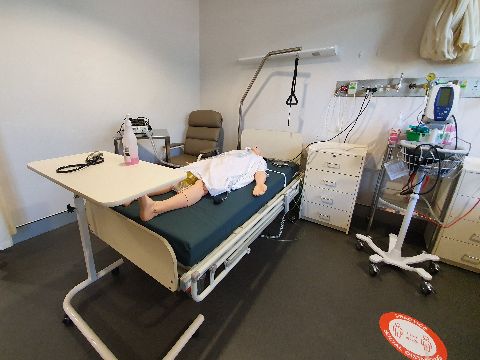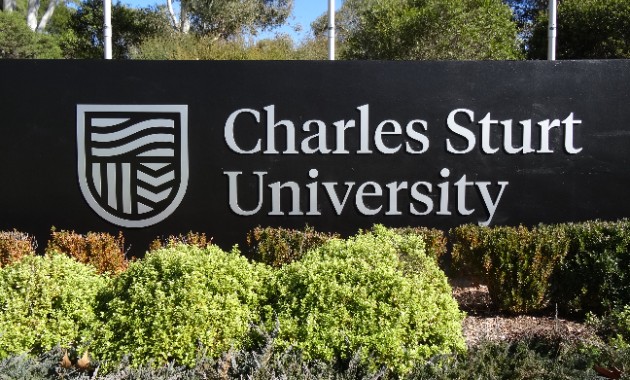- New student training facilities for the Charles Sturt University and Western Sydney University Joint Program in Medicine unveiled in first-look video
- Facilities include collaborative learning space, clinical skill rooms, ultrasound room, and anatomy lab based at Charles Sturt in Orange
- Applications for Medicine program open until Wednesday 30 September, with first cohort of medicine students to use facilities commencing in February 2021
 The new facilities that have been set up for students studying the Doctor of Medicine at the Charles Sturt University campus in Orange include eight clinical skills rooms, an ultrasound room, an anatomy lab, five problem-based learning rooms, and a collaborative learning space.
The new facilities that have been set up for students studying the Doctor of Medicine at the Charles Sturt University campus in Orange include eight clinical skills rooms, an ultrasound room, an anatomy lab, five problem-based learning rooms, and a collaborative learning space.
Development is still underway for the Academic and Research Hub, which will be the centrepiece of Charles Sturt’s School of Rural Medicine in Orange, and is expected to be completed in January next year.
The inaugural Dean of the Charles Sturt School of Rural Medicine Professor Lesley Forster said she is eager for the program’s future medicine students and members of the community to get a first glimpse at the student training facilities.
“On behalf of the Joint Program in Medicine, I am very proud to announce the state-of-the-art learning and teaching facilities we’ve created for our future medicine students are now ready to use,” Professor Forster said.
“These facilities, some of which are newly-built and some of which have been revamped and renovated, will play a fundamental role in training many future doctors of regional and rural Australia.
 “I am looking forward to seeing our first cohort of medicine students use these facilities to undertake their training, and build their knowledge about rural and regional medicine, in regional NSW.”
“I am looking forward to seeing our first cohort of medicine students use these facilities to undertake their training, and build their knowledge about rural and regional medicine, in regional NSW.”
The state-of-the-art student facilities include:
- A newly-built collaborative learning space where students will participate in practical and tutorial classes for medical sciences such as pharmacology, physiology, biochemistry and pathology.
- Eight renovated and updated clinical skills rooms that have been set up to simulate a real hospital room. These facilities will help train students to examine patients, complete practical procedures and use medical equipment.
- A renovated and revamped ultrasound room where students will learn how to use the ultrasound machine to examine and diagnose patients.
- A renovated and revamped anatomy lab that will help provide students with practical lessons about human body systems, organs, muscles, bones, nerves, tissue, and immune systems. These rooms will also help train students on physical exams, subsequent medical investigations and how disease affects the human body.
 Five renovated and revamped problem-based learning rooms where students will work in small groups to investigate a new clinical case each week.
Five renovated and revamped problem-based learning rooms where students will work in small groups to investigate a new clinical case each week.
Facilities still underway for the Charles Sturt School of Rural Medicine include The Academic and Research Hub, which will consist of rooms for staff, meeting rooms and research facilities, and the Clinical Skills Education Centre based at the Bloomfield Private Medical Centre in Orange.
The Centre recently received development approval and will include rooms for teaching clinical skills, tutorials and general learning, as well as meetings and conferences, and quiet rooms and other workspaces.
Prospective students have until Wednesday 30 September to apply for the Joint Program in Medicine through the Universities Admission Centre (UAC).
 The program has a strong focus on training medical students for a career in rural and regional medicine, with the majority of the cohort’s intake reserved for students from rural and regional areas. This means a minimum of 30 students in the cohort will hail from a rural or regional background.
The program has a strong focus on training medical students for a career in rural and regional medicine, with the majority of the cohort’s intake reserved for students from rural and regional areas. This means a minimum of 30 students in the cohort will hail from a rural or regional background.
Prospective students must apply through UAC and select Doctor of Medicine - Charles Sturt University/Western Sydney, Orange campus (UAC course code 725505) as one of their preferences.
On completion of the course, graduates will be qualified to commence work as a medical intern (pre-vocational training) within the hospital system and in the future be able to apply for a vocational specialist training program, such as general practice, surgery or other medical specialties.





Social
Explore the world of social